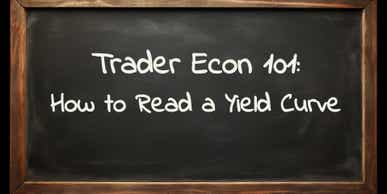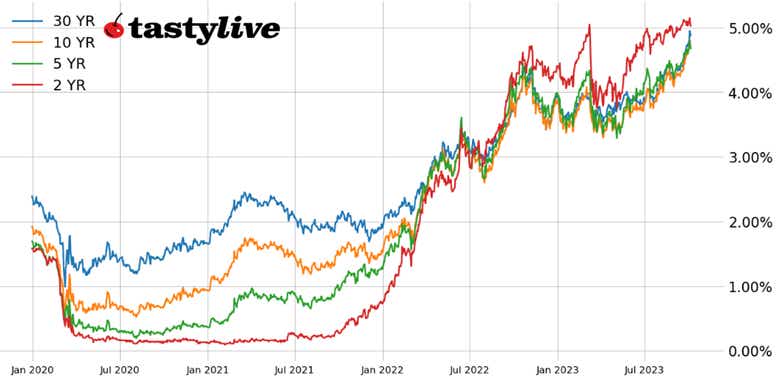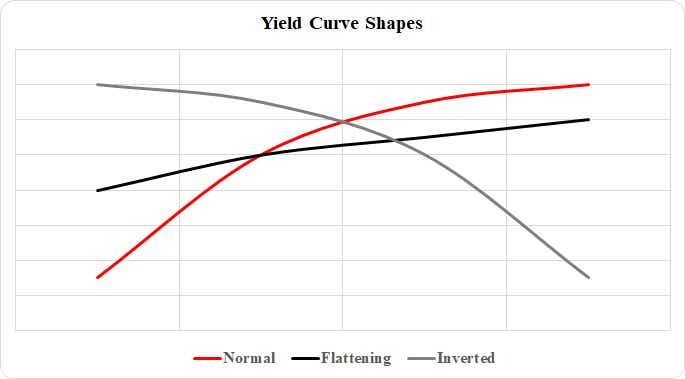What Do Bond Yields Say About the Economy?

What Do Bond Yields Say About the Economy?
Trader Econ 101: How to read a yield curve
- Yield curves can gives us insight into how the bond market views economic risks and potential changes in monetary policy.
- There are three different yield curve shapes: normal, flat and inverted.
- Contrary to popular opinion, the 2s10s spread is not the most important yield curve spread to watch to predict recessions.

Reading the yield curve
The yield curve shows how the yields of bonds with different maturities vary depending on the level of risk and the time horizon. A “normal” yield curve is upward sloping, meaning bonds with longer maturities have higher yields than bonds with shorter maturities. This is because investors demand more compensation for lending money for longer periods because there is more uncertainty and risk involved. A positive sloping yield curve reflects this “normal” relationship.
By looking at a government bond yield curve (such as U.S. Treasuries), one can make some judgments about the economic situation at any given time. For example, if the short-term rates are rising fast, this could indicate the central bank is planning to raise interest rates soon. Or it could mean the government is facing some funding problems.
On the other hand, if the long-term rates are falling sharply, this could suggest the prospects for economic growth are weakening. Or it could mean the government’s creditworthiness is improving. The context matters a lot.

What’s a flattening yield curve?
A flattening yield curve means the difference between the yields of long- and short-term bonds is narrowing. This happens when the yields of short-term bonds increase or the yields of long-term bonds decrease, or both.
For example, if a bond with a two-year maturity has a yield of 2%, and a bond with a 10-year maturity has a yield of 4%, the difference is 200 basis points. If the two-year yield goes up to 2.5%, and the 10-year yield goes down to 3.5%, the difference is now 100 basis points. The curve becomes flatter.
A flattening yield curve can signal the economy is slowing down and that inflation and interest rates are expected to remain low for a long time.
What is a steepening yield curve?
A steepening yield curve means the difference between the yields of long- and short-term bonds is widening. This happens when the yields of long-term bonds increase more than the yields of short-term bonds, or when the yields of short-term bonds decrease while the yields of long-term bonds increase.
For example, if a bond with a two-year maturity has a yield of 2%, and a bond with a 10-year maturity has a yield of 4%, the difference is 200 basis points. If the two-year yield goes up to 2.25%, and the 10-year yield goes up to 4.5%, the difference is 225 basis points. The curve becomes positively steeper.
A steepening yield curve can indicate the economy is growing stronger and that inflation and interest rates are expected to rise in the future.
What is an inverted yield curve?
Sometimes, the yield curve can become inverted, which means the yields of short-term bonds are higher than the yields of long-term bonds. This happens when investors expect interest rates to fall in the future, so they demand higher returns for holding short-term bonds than long-term bonds.
For example, if a bond with a two-year maturity has a yield of 2%, and a bond with a 10-year maturity has a yield of 4%, the difference is 200 basis points. If the two-year yield goes up to 2.5% and the 10-year yield goes down to 2%, the difference is now -50 basis points. The curve becomes negatively steeper or inverted.
An inverted yield curve can signal investors are pessimistic about the future of the economy and expect deflation and lower interest rates.
Which curve matters the most?
Duke University finance professor Campbell Harvey explored the idea of using the yield curve to forecast recessions in his 1986 dissertation. Contrary to popular opinion, the 2s10s spread (10-year yield minus two-year yield) is not the yield curve to watch.
Professor Harvey’s research indicates the 3m10s (10-year yield minus three-month yield) is the key yield curve, and it needs to invert for at least one full quarter (or three months) to give a true predictive signal (since the 1960s, a full quarter of inversion has predicted every recession correctly). The New York Federal Reserve tracks the 3ms10s spread to calculate the probability of a recession over the next 12-months.
Christopher Vecchio, CFA, tastylive’s head of futures and forex, has been trading for nearly 20 years. He has consulted with multinational firms on FX hedging and lectured at Duke Law School on FX derivatives. Vecchio searches for high-convexity opportunities at the crossroads of macroeconomics and global politics. He hosts Futures Power Hour Monday-Friday and Let Me Explain on Tuesdays, and co-hosts Overtime, Monday-Thursday. @cvecchiofx
For live daily programming, market news and commentary, visit tastylive or the YouTube channels tastylive (for options traders), and tastyliveTrending for stocks, futures, forex & macro.
Trade with a better broker, open a tastytrade account today. tastylive, Inc. and tastytrade, Inc. are separate but affiliated companies.
Options involve risk and are not suitable for all investors. Please read Characteristics and Risks of Standardized Options before deciding to invest in options.
tastylive content is created, produced, and provided solely by tastylive, Inc. (“tastylive”) and is for informational and educational purposes only. It is not, nor is it intended to be, trading or investment advice or a recommendation that any security, futures contract, digital asset, other product, transaction, or investment strategy is suitable for any person. Trading securities, futures products, and digital assets involve risk and may result in a loss greater than the original amount invested. tastylive, through its content, financial programming or otherwise, does not provide investment or financial advice or make investment recommendations. Investment information provided may not be appropriate for all investors and is provided without respect to individual investor financial sophistication, financial situation, investing time horizon or risk tolerance. tastylive is not in the business of transacting securities trades, nor does it direct client commodity accounts or give commodity trading advice tailored to any particular client’s situation or investment objectives. Supporting documentation for any claims (including claims made on behalf of options programs), comparisons, statistics, or other technical data, if applicable, will be supplied upon request. tastylive is not a licensed financial adviser, registered investment adviser, or a registered broker-dealer. Options, futures, and futures options are not suitable for all investors. Prior to trading securities, options, futures, or futures options, please read the applicable risk disclosures, including, but not limited to, the Characteristics and Risks of Standardized Options Disclosure and the Futures and Exchange-Traded Options Risk Disclosure found on tastytrade.com/disclosures.
tastytrade, Inc. ("tastytrade”) is a registered broker-dealer and member of FINRA, NFA, and SIPC. tastytrade was previously known as tastyworks, Inc. (“tastyworks”). tastytrade offers self-directed brokerage accounts to its customers. tastytrade does not give financial or trading advice, nor does it make investment recommendations. You alone are responsible for making your investment and trading decisions and for evaluating the merits and risks associated with the use of tastytrade’s systems, services or products. tastytrade is a wholly-owned subsidiary of tastylive, Inc.
tastytrade has entered into a Marketing Agreement with tastylive (“Marketing Agent”) whereby tastytrade pays compensation to Marketing Agent to recommend tastytrade’s brokerage services. The existence of this Marketing Agreement should not be deemed as an endorsement or recommendation of Marketing Agent by tastytrade. tastytrade and Marketing Agent are separate entities with their own products and services. tastylive is the parent company of tastytrade.
tastyfx, LLC (“tastyfx”) is a Commodity Futures Trading Commission (“CFTC”) registered Retail Foreign Exchange Dealer (RFED) and Introducing Broker (IB) and Forex Dealer Member (FDM) of the National Futures Association (“NFA”) (NFA ID 0509630). Leveraged trading in foreign currency or off-exchange products on margin carries significant risk and may not be suitable for all investors. We advise you to carefully consider whether trading is appropriate for you based on your personal circumstances as you may lose more than you invest.
tastycrypto is provided solely by tasty Software Solutions, LLC. tasty Software Solutions, LLC is a separate but affiliate company of tastylive, Inc. Neither tastylive nor any of its affiliates are responsible for the products or services provided by tasty Software Solutions, LLC. Cryptocurrency trading is not suitable for all investors due to the number of risks involved. The value of any cryptocurrency, including digital assets pegged to fiat currency, commodities, or any other asset, may go to zero.
© copyright 2013 - 2025 tastylive, Inc. All Rights Reserved. Applicable portions of the Terms of Use on tastylive.com apply. Reproduction, adaptation, distribution, public display, exhibition for profit, or storage in any electronic storage media in whole or in part is prohibited under penalty of law, provided that you may download tastylive’s podcasts as necessary to view for personal use. tastylive was previously known as tastytrade, Inc. tastylive is a trademark/servicemark owned by tastylive, Inc.